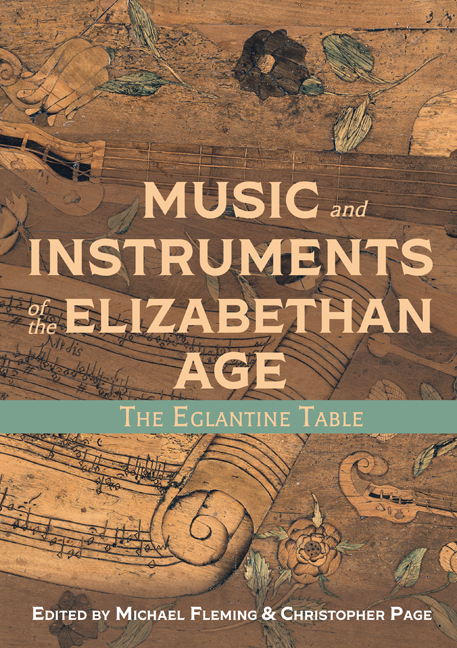Book contents
- Frontmatter
- Dedication
- Contents
- List of Illustrations
- Foreword
- Acknowledgements
- Note to the Reader
- List of Abbreviations
- Introducing the Eglantine Table
- Part I Silent Things
- Part II Music and Instruments
- Part III Broader Views of the Eglantine Table
- Appendices
- Glossary
- Bibliography
- List of Contributors
- Index
- Plate section
5 - The Music in Staff Notation
Published online by Cambridge University Press: 24 March 2021
- Frontmatter
- Dedication
- Contents
- List of Illustrations
- Foreword
- Acknowledgements
- Note to the Reader
- List of Abbreviations
- Introducing the Eglantine Table
- Part I Silent Things
- Part II Music and Instruments
- Part III Broader Views of the Eglantine Table
- Appendices
- Glossary
- Bibliography
- List of Contributors
- Index
- Plate section
Summary
Four objects bearing music in staff notation are depicted on the Eglantine Table: two books and two scrolls. Many viewers of the Table today will pass over these objects fairly quickly, pausing only to observe their painstaking execution in marquetry and inscription. Even a musically literate viewer might gaze at them only long enough to pick out some of the melodies, and perhaps identify the musical genres represented. Elizabethan viewers, in contrast, could have been richly rewarded by looking closely at these notations, or hearing them sung by others. Not only would some of them have recognised familiar musical works, they might also have perceived how these pieces could allow deeper interpretation of the Eglantine Table itself. This chapter tries to make sense of these four objects (Plate 2), though it does so in the knowledge that aspects of their choice and presentation may once have conveyed symbolic meanings that are now hard to determine with confidence, or meanings of a local or personal kind that are now impossible to retrieve. For the reader's convenience, transcriptions of the musical works are supplied at the end of this chapter, in editions prepared collaboratively with David Skinner and Timothy Symons.
An important first point is that all four objects are physically credible, in the sense that they depict artefacts a Tudor musician would typically have used when reading or performing musical works. Plates 13a–b show the two opened music books placed on opposite sides of the Table. These depictions have been simplified only in the sense that each page bears two staves of musical notation, whereas a true music book in oblong format would more likely have featured three or more staves. Clearly this simplification has been forced on the designer by the need to burn or inscribe the notation into wood with a stylus, and arguably it represents the tightest level of legible miniaturisation the craftsmen could achieve. Plates 12 and 14 show the two scrolls, a format that was once common for musical works, though surviving Tudor examples are rare. Absent from the Table are other formats commonly used by musicians – flat sheets and pamphlets bearing musical notation – but a flat sheet can be rolled up for safekeeping, and therefore turned into a scroll.
- Type
- Chapter
- Information
- Music and Instruments of the Elizabethan AgeThe Eglantine Table, pp. 69 - 100Publisher: Boydell & BrewerPrint publication year: 2021



